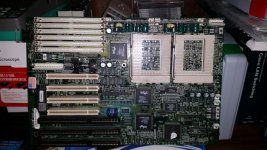I been wanting to build a dual first gen Pentium MMX or PPro system for years. But every time I set out to do this something gets in the way.
Now I'm tossing around the idea again. I want to keep the system as 1996-1997 as possible and I want to ask a few things.
From a 32bit gaming stand point would a 1mb l2 or 512mb l2 CPU be worth getting. From the way I look at it would be since I'm not going to be doing and Overclocking.
Were there any 50 or 68 pin scsi drives out there that were not extremely loud? I don't mind the chirping or clicking sounds, but the motor and disk spinning sounds can get to me. I'm sure any good 5400 rpm drive should be ok.
Also what would you say is a good 96-97 scsi raid card is? Anything to look for? This is a time frame I'm not all to well vested in, 1 or 2 years newer or older and I would know what to get.
I'll need a full size AT board for my system. Any suggestions? Places to look for information on the old socket 8 broads
Now I'm tossing around the idea again. I want to keep the system as 1996-1997 as possible and I want to ask a few things.
From a 32bit gaming stand point would a 1mb l2 or 512mb l2 CPU be worth getting. From the way I look at it would be since I'm not going to be doing and Overclocking.
Were there any 50 or 68 pin scsi drives out there that were not extremely loud? I don't mind the chirping or clicking sounds, but the motor and disk spinning sounds can get to me. I'm sure any good 5400 rpm drive should be ok.
Also what would you say is a good 96-97 scsi raid card is? Anything to look for? This is a time frame I'm not all to well vested in, 1 or 2 years newer or older and I would know what to get.
I'll need a full size AT board for my system. Any suggestions? Places to look for information on the old socket 8 broads

